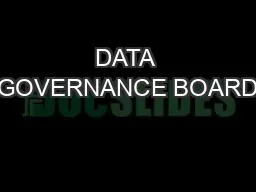

Disclosure AvoidanceWho Why and HowDisclosure AvoidanceOne of the main responsibilities of data governance at the US Department of Education ED is working to ensure the security of data assets managed ID: 897283
Download Pdf The PPT/PDF document "DATA GOVERNANCE BOARD" is the property of its rightful owner. Permission is granted to download and print the materials on this web site for personal, non-commercial use only, and to display it on your personal computer provided you do not modify the materials and that you retain all copyright notices contained in the materials. By downloading content from our website, you accept the terms of this agreement.
1 DATA GOVERNANCE BOARD Disclosure Avoidan
DATA GOVERNANCE BOARD Disclosure Avoidance:Who, Why, and HowDisclosure AvoidanceOne of the main responsibilities of data governance at the U.S. Department of Education (ED) is working to ensure the security of data assets managed by ED. Much of the data collected by ED is protected under one or Technical Assistance • Advise and assist with selection and design of a disclosure avoidance method and assist in its application • Guide documentation included in a disclosure avoidance plan Evaluation • Evaluate the disclosure/re-identification risk for proposed data releases • Assess the effectiveness of the disclosure avoidance plan at mitigating those risks Recommendations • Issue a written determination (“Safe to Release” memo) for each proposed data release • Document whether/how the discloure risks have been sufficiently mitigatedDisclosure Review Board Members and Meeting Structure DATA GOVERNANCE BOARD Current DRB member offices include the following: • Office of Management, Office of the Chief Privacy Officer (DRB Chair) • EDFacts • Institute of Education Sciences, National Center for Education Statistics • Federal Student Aid • Office for Civil Rights • Office of Career, Technical, and Adult Education • Office of Elementary and Secondary Education • Office of the General Counsel • Office of Planning, Evaluation, and Policy Development • Office of Special Education and Rehabilitative Services Collaborative Review ProcessDRB utilizes a collaborative review process to ensure ED
2 releases as much useful data as possibl
releases as much useful data as possible while protecting privacy. The Board provides a submission checklist for program offices to follow to prepare disclosure avoidance methodologies associated with a data release for review. Included in this submission are data, descriptions of the data elements, disclosure avoidance methodologies, and supplementary material. DRB reviews and approves the disclosure avoidance methodologies and strives for consensus among board members in each of the reviews they complete. In some cases, submissions might initially be rejected in order to improve upon disclosure avoidance methodologies. The Board encourages program offices that release data to think about disclosure avoidance early in the release process and consider the implications for ensuring PII are not disclosed during implementation. Disclosure avoidance should not end with the approval of DRB.Disclosure avoidance methodologiesThere are several disclosure avoidance methods that DRB reviews such as data suppression, rounding, recoding, swapping, additive noise, differential privacy, and other statistical methods. Application of these methods can vary from simple suppression rules to complex statistical techniques, and each method impacts the usability of the resulting data in different ways. Program offices must carefully consider the intended uses of any public data release in order to select the disclosure avoidance method or methods that optimize the usability of the data for those purposes. EDGB general inquiries: EDFacts@ed.gov ED’s Data Governance:https://www2.ed.gov/about/inits/ed/edfacts/index.htm